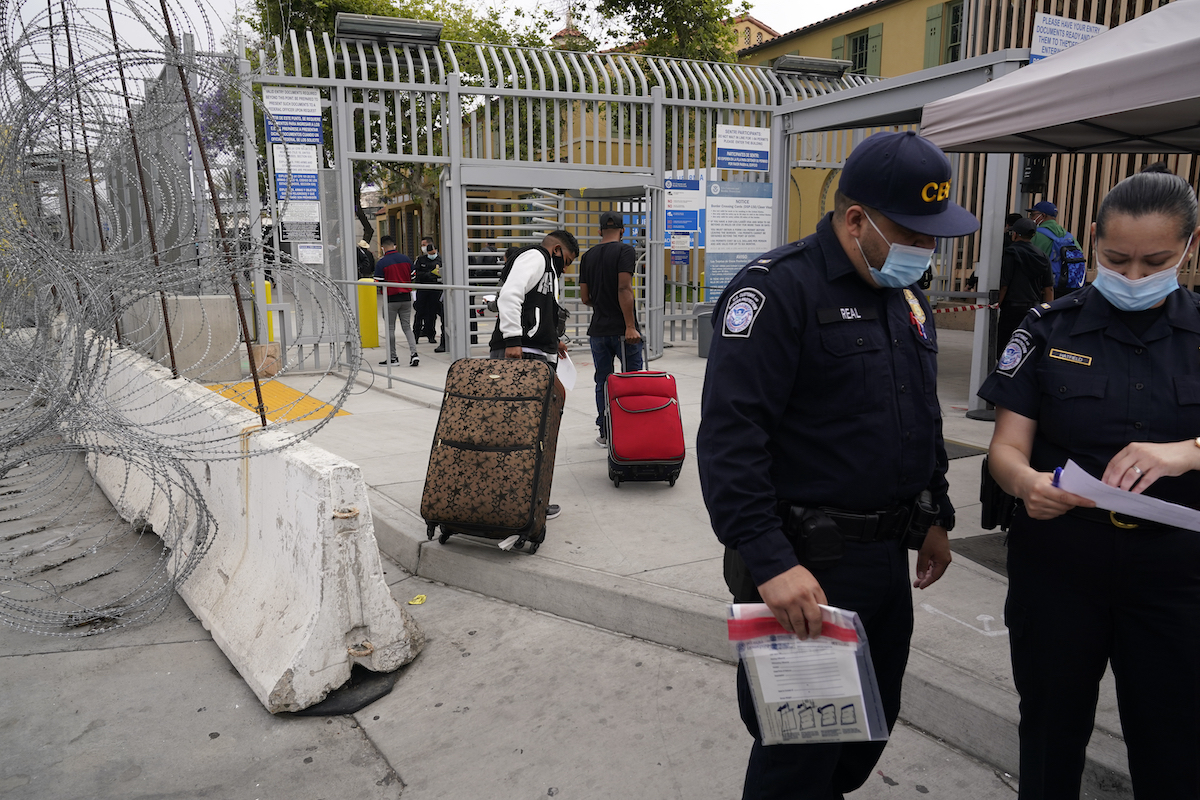

In this July 5, 2021 file photo, Honduran Alex Cortillo, left, and his stepbrother pull their suitcases to the border crossing into the U.S. to begin the asylum process, in Tijuana, Mexico. (AP Photo/Gregory Bull, File)
By MARÍA VERZA, Associated Press
MEXICO CITY (AP) — Mexico’s president again sidestepped questions Thursday about the reinstatement of the U.S. “Remain in Mexico” policy.
President Andrés Manuel López Obrador said Mexico will continue helping the United States on immigration. But he noted “it can’t go on forever,” and said attention must turn to development in Central America so people don’t have to emigrate.
“We have taken it upon ourselves to help the U.S. government on the immigration issue, we are going to continue to do so,” López Obrador said.
“We have tried to keep migrants in shelters, above all to protect minors, women,” the president said. “But this can’t go on forever, we have to get to the bottom of the issue and that means investing in the development of poor countries.”
That was an apparent reference to López Obrador’s proposal to expand Mexico’s mass tree-planting program into Central America, which pays farmers to plant fruit and timber species. The U.S. government has so far been slow to take up the proposal.
In Mexico, the program has been dogged by accusations it encourages farmers to cut down existing trees in order to be paid for planting new ones.
Mexico is not legally bound to accept the U.S. policy of sending non-Mexican asylum seekers back across the border to wait for hearings on their claims, and most asylum seekers aren’t Mexican.
Mexico allowed non-Mexicans to be sent back under the administration of Donald Trump, but Mexican officials haven’t said if they will allow it to resume.
The U.S. Supreme Court refused Tuesday to block a lower-court ruling ordering the administration of President Joe Biden to reinstate the Trump-era policy of forcing people to wait in Mexico for hearings on asylum claims.
Roberto Velasco, Mexico’s director for North American affairs, said Wednesday the court ruling is not binding on Mexico. He stressed that Mexico’s “immigration policy is designed and executed in a sovereign manner.”
“The Mexican government will start technical discussions with the U.S. government to evaluate how to handle safe, orderly and regulated immigration on the border,” Velasco said. López Obrador endorsed that position Thursday.
López Obrador has had good relations with the U.S. government on immigration matters and has cooperated in blocking migrant caravans and deporting migrants trying to reach the U.S. border. López Obrador said Thursday that relations remained good under Biden.
It’s not clear how many people will be affected by the Supreme Court ruling and how quickly. Under the lower court ruling, the administration must make a “good faith effort” to restart the program.
There also is nothing preventing the Biden administration from trying again to end the program, formally called Migrant Protection Protocols.
During Trump’s presidency, the policy required tens of thousands of migrants seeking asylum in the U.S. to turn back to Mexico. It was meant to discourage asylum seekers, but critics said it denied people the legal right to seek protection in the U.S. and forced them to wait in dangerous Mexican border cities.
During the Trump administration, the Mexican government said it was cooperating with the program for humanitarian reasons.
Although migrants were granted humanitarian visas to stay in Mexico until they had their U.S. hearings, they often had to wait in dangerous areas controlled by cartels, leaving them vulnerable to being kidnapped, assaulted, raped or even killed. Others were transported by bus to parts of southern Mexico or “invited” to return to their home countries.
Workers at shelters on the northern border, where conditions are already crowded and migrant tent camps have sprung up again, expressed concern.
“We are worried because there are a lot of people here,” said Maria de la Luz Silva who works at the Senda de la Vida migrant shelter in the border city of Reynosa, across from McAllen, Texas.
While a tent encampment closed down in the nearby city of Matamoros after Biden suspended Remain in Mexico, now a similar encampment of about 2,000 migrants has sprung up near a border bridge in Reynosa.
“We believe it will be a very hard situation, very difficult,” said Rev. Francisco Gallardo, director of the Matamoros Casa del Migrante shelter. He called the encampments “inhumane” and called on authorities to prevent a repeat of such conditions.
Mexico technically could block the return of the Remain in Mexico program by refusing to accept migrants asked to stay there under what is formally known as the Migrant Protection Protocols. But analysts like Tonatiuh Guillén, former head of Mexico’s migration agency, consider that unlikely given the country’s history of cooperation with the U.S.
Guillén said Mexican officials will probably go along even though the country doesn’t have sufficient resources to deal with an influx of asylum seekers at the border and nonprofit shelters south of the border are overwhelmed.



so basically extortion. .im assuming everybody thinks it the United States job to fix and develop and fix central america? omg. how about each country figures it out on their own and everyone keeps their people inside their borders. smh